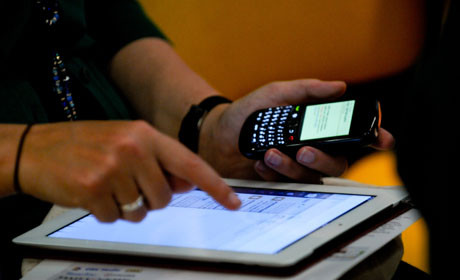
Until recently The Economist's model was lean forward, lean back publishing. Readers of the print publication and tablet apps, who often spend more time on articles, were considered lean back; the web audience was seen as lean forward, with social media helping spread content between online readers.
The Economist is now moving away from that lean forward, lean back model, Neelay Patel, vice-president of commercial strategy and global head of product at The Economist Group told Mobile Media Strategies, a conference underway in London today.
He said the shift in thinking is due to the rise in mobile devices of different types and sizes, and the increase in touch screens.
"We now need to be touch first and mobile second," said Patel, explaining how The Economist considers how people will press images and other content on a touch screen.We now need to be touch first and mobile secondNeelay Patel, The Economist Group
People are making less conscious decisions as to where to consume media, he said. Readers move between devices, which is why The Economist is ensuring content is available for as many devices as possible.
The Economist's aim is now to "get people to the end of every article" as the focus moves away from "encouraging people to click on ads", Patel said.
The publisher is now aiming for consistency across platforms, rather than focusing on the lean forward, lean back split, but is also "exploiting the relative strength of each platform", recognising that mobile readers behave differently to those using a tablet.
There are three steps to the new model:
1. Identify the key strength of offering
The Economist knows its strength; it provides a global view on a wide range of topics, Patel said. And the product is "a tidy, curated, finishable package". Digital allows this offering to spread more widely as people can access it from anywhere in the world, and on any device.
2. Identify the specific role of each product and each feature
Each product and feature must have a sense of purpose, Patel said. It is essential that this role can be explained clearly to readers as well as those internally within the company.
Patel used the example that if people want to get personalised news and find every article relating to Brazil, for example, there is an app that allows them to do that.
3. Identify the role of technology
Patel said it was important not to "introduce technology for technology's sake", but that it should enable a seamless reading experience and allow people to access the key strength of the offering.
Readers should not remember the particular device on which they read an article or saw an ad, whether in print, on a smartphone, tablet or desktop.
"If we execute this correctly, all devices should fall away and leave nothing but the content," he said.
Free daily newsletter
If you like our news and feature articles, you can sign up to receive our free daily (Mon-Fri) email newsletter (mobile friendly).
Related articles
- Five media sustainability lessons from The Economist
- The Economist launches podcast-only news subscription
- Executing the user needs model 2.0 with Dmitry Shishkin
- DCMS-backed media literacy programme is supporting vulnerable internet users
- WSJ, Economist and FT all now have women editors – what does it mean for business?











